
-
@gemuesesaft I missed your post, sorry. How did you use that LanC controller? The Pocket does not support power-on via LANC (unfortunately). If you just used it to start record on both cams (like I do on my own controller) that doesn't give you sync unfortunately, the error will be random.
I could use your help, see next post:
-
I've cracked the cams open. I'll post some news about that (no clock syncing yet) when I get some parts I need to check my results. In the meantime, here's a high-res pic of the main board.
I'm particularly interested in the silver package right above the FPGA, that's probably its clock oscillator. Luckily it's also one of the few components with legs & large enough solder points that I could hack - most of the other components are impossible (for me anyway).
I can't find anything on its marking though (not even via image search):
300844
ACV03W(or 3OW?)
14201420 probably refers to 1.42/14.2/142MHz. Anyone?
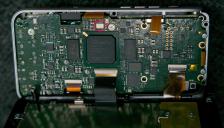
 Pocket Main Board (front).jpg5376 x 3070 - 2M
Pocket Main Board (front).jpg5376 x 3070 - 2M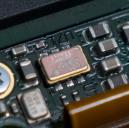
 poss. clock IC.jpg1596 x 1584 - 628K
poss. clock IC.jpg1596 x 1584 - 628K -
Hey, We powered on the cameras at the same time manually, the lanc controller shows the drift via LED. Then we hit record at the lanc controleler. BUT ITS ALL OBSOLETE NOW ! Check this out: https://www.blackmagicdesign.com/de/products/blackmagicmicrocinemacamera It has freakin GENLOCK and GLOBAL SHUTTER.
ALL Problems solved. I recommend putting back together your BMPCC as fast as you can and sell it!
cheers
-
An idea whose time has come, hmm?
Sadly, I needed the camera to be 64mm or less (and 4k) for my purposes...
At least it will be great for traditional cinema use.
-
Hey @gemuesesaft, what were your results? Illness knocked me out for a while, but power-hacking the cams gets me ~1ms or better sync error clips now (details later). It's still a good solution for many things, and I'll be doing more shots with it soon.
But yeah, the Micro Cines look perfect on paper (I've got two on pre-order), we'll have to see how the footage turns out and how exactly genlock works out in practice (talking to BMD about it). Hopefully BMPCC Speedboosters will work on it, also does it actually give 13 stops in Global shutter mode (usually global shutter modes are less sensitive)?
Also they don't have built-in screens, so you need a monitor. I'm just writing software that can turn a Windows tablet (or laptop/PC) into a 3D and 2D monitor. I'll post more details soon, but I'm planning full touchscreen remote control of the Micro cameras, anaglyph previews etc. That means a battery powered tablet can run the entire rig + do everything else a Windows device can.
-
How I hacked the Pockets for synced power-on - Part 1:
.
(warning: at your own risk yada yada, soldering experience required, solder the camera button as cool as possible, and don't solder the other parts while connected to the camera!)..
.
How to open (not mine, take the lens off first):I first looked at the small PCB that holds the front panel buttons. Impossible to hack for me, no easy solder access and damage risk too high. I tried to get all this done the night before an important shoot, so I was stuck.
Then I found button SW5 on the main PCB - this is a duplicate of the front panel power button, and is used for testing the board. And it has exposed legs that you can solder to!
See pics, you want to solder a wire at the bottom (either side, positive) and top (ditto, negative). Surprisingly the button caries whatever the power voltage is - so with external 12V connected, it gets 12V (would have expected a consistent regulated voltage there).
I squeezed the cables into a tiny gap at the side, and secured them there and at the solder point with hotglue. Don't want them coming loose later. They then come out between the rubber and metal body (could cut the rubber for a cleaner finish).
I soldered standard 3.5mm stereo (headphone-style) sockets to my wires. This way the cameras can be disconnected + commonly available extension cables can be used for wider interaxials.
Next, the switch ...
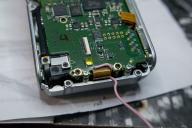
 wire1HI.jpg1920 x 1280 - 320K
wire1HI.jpg1920 x 1280 - 320K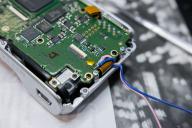
 wire2HI.jpg1920 x 1280 - 317K
wire2HI.jpg1920 x 1280 - 317K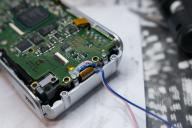
 hotglueHI.jpg1920 x 1280 - 261K
hotglueHI.jpg1920 x 1280 - 261K
 reassemblyHI.jpg1920 x 1280 - 498K
reassemblyHI.jpg1920 x 1280 - 498K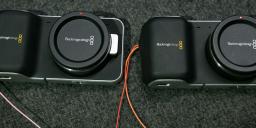
 reassembledHI.jpg1920 x 735 - 297K
reassembledHI.jpg1920 x 735 - 297K -
How I hacked the Pockets for synced power-on - Part 2:
.
Now we need to switch on both cameras together. At first I made a more complex trigger with its own button and 2 MOSFETs. It kinda worked, but due to a design flaw (missing resistors) they triggered each other in strange ways.
It dawned on me that it's much simpler to use a single MOSFET + 1 resistor. The idea is that you switch power directly on the master camera as usual. Its juice triggers the MOSFET, which allows the 2nd camera's own power to flow through it (a MOSFET is an electronic switch). As MOSFETs switch very fast, they both switch on (and off) together.
Works great and is simple to make (see pics). Parts:
. -2SK4033 (N-channel MOSFET, logic level, should support 20+Volts comfortably)
My part is surface-mount, so tricky to solder (larger DIP style ones are available), but low-profile & fits Perfboard nicely.
- ~360 ohm resistor.
.
Results:
Sync (measured with my own LANCdrift3r) often show 1ms or less sync error. However sometimes it's way out, so may have to switch on and off again. Not sure yet what the cause is, it may be battery charging state, power state, SD card, or the cam may still be busy behind the scenes after the screen switches off (possible, as waiting a few seconds helps). However it works most of the time so very usable.
On mine the error typically is < -1ms, and then it gradually drifts towards zero, which is ideal. YMMV.
. Note: due to the way the Pockets scan the power button (badly), sometimes one cam turns on/off and the other doesn't. Just hold the power button for a few seconds, then both will be off together.
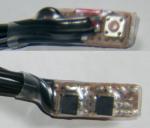
 first circuit.jpg640 x 547 - 52K
first circuit.jpg640 x 547 - 52K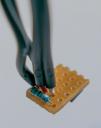
 SyncPCB-front.jpg640 x 809 - 46K
SyncPCB-front.jpg640 x 809 - 46K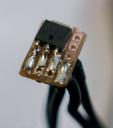
 SyncPCB-back.jpg640 x 728 - 60K
SyncPCB-back.jpg640 x 728 - 60K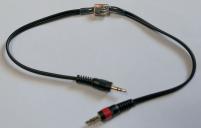
 SyncCable.jpg640 x 408 - 25K
SyncCable.jpg640 x 408 - 25K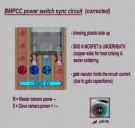
 final circuit (corrected).jpg1136 x 1080 - 156K
final circuit (corrected).jpg1136 x 1080 - 156K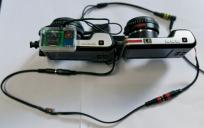
 SyncedPocketsHI.jpg1920 x 1203 - 175K
SyncedPocketsHI.jpg1920 x 1203 - 175K -
That's a pretty crazy inter-occular you've got going in that picture. Have you thought about flipping your "left eye" around to better approximate something human?
-
Not possible without a global shutter, as jello would not match. If you maintain a minimum distance to the nearest object (I use ~3m) it works fine. Here is a sample from my old GH2 rig with similar interaxial (although people got closer than I wanted):
... or you can use a beamsplitter to get any interaxial (useful for larger screen projection).
-
Yeah, some of the 35mm solutions used a beam splitter, either to two cameras or stacking eyes, one eye per two-perfs. You end up with some exposure variance in one eye but the brain is fairly forgiving in this regard and more or less averages them together.
Interesting though about the jello. Have you tried it out to see if it falls apart? I ask because I'm doing some effects for this indie film where they used a complete shit pile of a camera that doesn't even record two whole streams of information for each eye, the right eye is stored as delta information, basically. There's all kinds of macroblocking and distortion and the incredible noise makes for this rainbow film at screen level. It's horrible and almost impossible to track to because nothing maintains geometric integrity it's so highly compressed.
If this thing generates stereo that's acceptable to people I just wonder if a sometimes difference in jello would be such a deal breaker, but it's sometimes surprising what does and doesn't cause immediate fatigue.
-
You mean from polarisation differences (the splitter rotates the polarisation of incoming light for one camera)? You should be able to work around this with a quarter-wave retarder, although I don't know how practical that is with common rigs?
I also saw spectral differences from a similar mirror-based system, but you can usually grade around that. I don't have the full Resolve, but it has stereo colour matching (as does my own software LumaChroma3D, which I used to edit the above).
-
The last time I worked with stereo film material it was around 1996 or so (T23D). I don't think the rig used was more sophisticated than a passive splitter. In some instances these rigs were mounted to motion-control cameras shooting miniatures so it had to be as light and compact as possible.
The stereo consultant on that project juiced both the convergence and inter-occular on virtually every shot for maximum stereo separation. Reviews were often exhausting. So much of it is stereo designed for hammerhead sharks, I liked to say. His goal was to get items poking into the audience closer than some objects in the Captain Eo film at Disney which, at the time, was the benchmark for in-yo-face.
-
Cool, I've not seen T23D (UK bound), maybe someday I'll get to. + I like your hammerhead sharks analogy : ).
But yeah the BMD cams give you amazing 3D quality for the money. Shame you have to hack the Pockets just to power them on together, no such problems on my old GH2 rig as they have real power switches, not software ones.
If the Micros match the IQ and DR, and all the genlocking & remote control stuff works out in practice, they will be sweet.
-
Yeah, I think the applications for the Micro are gonna just blow up. There have been high quality cameras that small or smaller, like those used by Danny Boyle on a few films, but they cost as much as a Scarlet I'm pretty sure, and had to be tied to an external recorder I believe.
-
_gl when will we see footage of your couple ?
-
@gemuesesaft, I've actually only been on one shoot since my last post here, illness and other priorities got in the way and now I'm preparing for the Micro Cines. I'll throw a quick demo together soon.
-
push!
Howdy, Stranger!
It looks like you're new here. If you want to get involved, click one of these buttons!
Categories
- Topics List23,993
- Blog5,725
- General and News1,354
- Hacks and Patches1,153
- ↳ Top Settings33
- ↳ Beginners256
- ↳ Archives402
- ↳ Hacks News and Development56
- Cameras2,368
- ↳ Panasonic995
- ↳ Canon118
- ↳ Sony156
- ↳ Nikon96
- ↳ Pentax and Samsung70
- ↳ Olympus and Fujifilm102
- ↳ Compacts and Camcorders300
- ↳ Smartphones for video97
- ↳ Pro Video Cameras191
- ↳ BlackMagic and other raw cameras116
- Skill1,960
- ↳ Business and distribution66
- ↳ Preparation, scripts and legal38
- ↳ Art149
- ↳ Import, Convert, Exporting291
- ↳ Editors191
- ↳ Effects and stunts115
- ↳ Color grading197
- ↳ Sound and Music280
- ↳ Lighting96
- ↳ Software and storage tips266
- Gear5,420
- ↳ Filters, Adapters, Matte boxes344
- ↳ Lenses1,582
- ↳ Follow focus and gears93
- ↳ Sound499
- ↳ Lighting gear314
- ↳ Camera movement230
- ↳ Gimbals and copters302
- ↳ Rigs and related stuff273
- ↳ Power solutions83
- ↳ Monitors and viewfinders340
- ↳ Tripods and fluid heads139
- ↳ Storage286
- ↳ Computers and studio gear560
- ↳ VR and 3D248
- Showcase1,859
- Marketplace2,834
- Offtopic1,320
Tags in Topic
- camera 247
- rig 106
- cinema 73
- bmpcc 61
- 3d 60
- pocket 26
- sync 12
- synchronization 3
- stereoscopic 3




